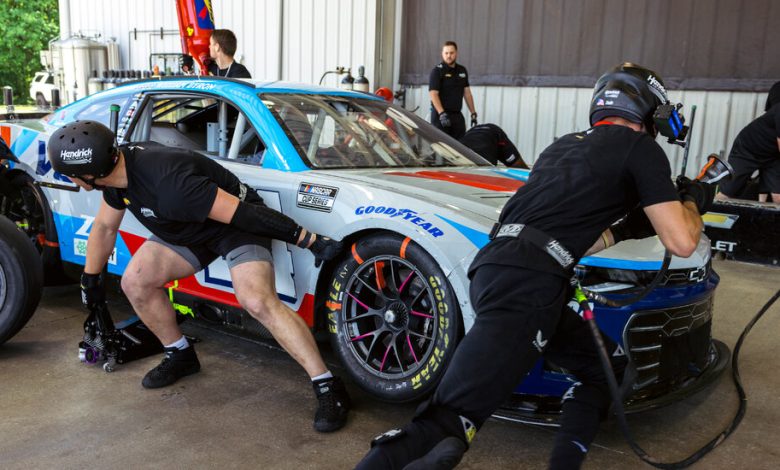NASCAR and Its Race Teams Fight Over the Sport’s Future

When Michael Jordan and his right-hand man, Curtis Polk, bought a NASCAR team in 2020 with the driver Denny Hamlin, they were prepared to endure short-term losses. Drivers, mechanics and a sales staff had to be hired. The Next Generation cars that were introduced in 2022 would cost top teams about $18 million a year to run before paying a driver, and their team, 23xi, had two. Paying for a new building to house the cars would cost tens of millions of dollars more.
But they believed they’d make that money back over time because NASCAR had a lot of room to grow. They predicted, accurately, that television viewership and attendance, while not returning to their numbers from a decade ago, would pick up in recent years. Sponsorships, the lifeblood of every race team, were still in demand, especially for a team owned by a basketball legend like Jordan. They also guessed that the value of the sport’s broadcast rights would increase, a hunch confirmed in November, when NASCAR signed a seven-year, $7.7 billion deal with Fox, NBC, Amazon and Warner Bros. Discovery.
They are struggling to make a return on their investment, however. The main reason, they said, is NASCAR’s reluctance to share more of its growing revenue with 23xi and the 15 other racing teams in the NASCAR Cup Series.
“In all partnerships, if you grow the pie, that means your business is going to continue to grow,” Jordan said in an interview. “And to grow the pie, you’ve got to make sure everybody’s healthy within the partnership. If our ownership in NASCAR is losing money and NASCAR’s the only one making money, that’s not a good partnership.”

Michael Jordan with Curtis Polk, left, co-owners of the 23xi race team. “If our ownership in NASCAR is losing money and NASCAR’s the only one making money, that’s not a good partnership,” he said.Credit…Peter Casey/USA Today Sports
For more than two years, the racing teams and NASCAR have essentially been at a standstill about the financial future of the sport. In sporadic talks between the sides, NASCAR has offered a modestly larger share of its new broadcast contract to the teams. But it has balked at the teams’ request that it share revenue from any future money streams like gambling, and it has refused their calls to make permanent the charters that teams must own to operate their cars.
Teams, most of which lose money each year under the current model, said that this hurt their ability to prepare for the future, scared investors away and made operations tenuous at a time when NASCAR seemed flush.
But the continuing dispute is not just about revenue. It’s about competing visions for stock car racing. Will it remain popular but provincial or will it recast itself more like a major sports league?
NASCAR declined to make an executive available to comment for this article, but in November, Steve Phelps, NASCAR’s president, said that his organization wanted “to change the paradigm for our race teams and we need to make sure our race teams are profitable, competing on the racetracks.”
At a sports industry conference two weeks ago, Steve O’Donnell, NASCAR’s chief operating officer, said that a deal with the teams was “very close,” without elaborating.
Unlike the National Basketball Association, the National Football League and most other sports leagues, NASCAR is a privately held business that is tightly controlled by the France and Kennedy families. NASCAR is the sanctioning body for the sport, but it also owns many of the tracks where the races are held and sells its own national sponsorships and broadcast deals.
Teams are independent businesses that compete fiercely on the track and for sponsorships, which make up well more than half their revenue. Roughly 30 percent of NASCAR’s broadcast revenue is also split between the teams. Teams also win shares of track purse payouts. Only recently have the teams had unified representation in discussions with NASCAR.
And unlike the New York Yankees or the Los Angeles Lakers, the teams are not permanent franchises. They can lose their charters if they fail to put cars on the track each week or if they perform poorly. The charters can be sold, allowing team owners to recoup some of their investments when they exit the sport. (NASCAR does not release figures on charter sales, but teams said prices had risen steadily. The most recent sale is said to have fetched $40 million).
The charters obligate teams to enter all their cars in all 36 cup races and two exhibitions each season. The cost of hauling cars and flying race teams around the country each week is significant. Teams also must pay fees to enter each race, buy credentials for their personnel and set up their own hospitality suites at the tracks.
“I think that the teams want to play in that playground, and if you want to play in that playground, you’ve got to abide by NASCAR’s rules,” said Tom Cotter, a former spokesman for the Charlotte Motor Speedway who also ran the country’s largest motor sports management agency. “But it’s worked out well for, I think, both sides. NASCAR has made a lot of money and these teams have, until recently, made a good living.”
Most race teams lose money under the current economic model, however, and they expect to collectively lose more than $200 million over the next five years if nothing changes.
NASCAR issued the charters to qualified teams in 2016 to give them equity that they could sell or borrow against. But they were granted for only the length of the current broadcast rights deal, which expires at end of this year. (Since 2016, 11 teams have either closed, merged or gone bankrupt.) The teams said that NASCAR offered to give them a larger slice of the new broadcast deal, but would renew the charters for only seven years, the length of the upcoming broadcast contract. Polk and other team owners and executives said that the uncertainty around the charters made it hard for them to invest in their operations and it scared off outside investors.
“Until we are all aligned and paddling the boat in the same direction, we’ll never be able to reach the full potential that NASCAR has,” Polk, a member of the five-man committee negotiating with NASCAR, said in an interview. “There’s just a ton of money on the sidelines that wants to invest in big-time sports, and NASCAR is a big-time sport. It’s not what it was in the early 2000s, but there’s no reason it can’t get back there again.”
The teams do not seem as optimistic. They want to negotiate “but they won’t take an unacceptable deal,” said Jeffrey Kessler, a leading antitrust lawyer who has represented the N.F.L. Players Association and other unions, and is now working for the NASCAR racing teams. “I was hired to help them think through their options.”
One option was for the teams to form their own race series with all the top racers and owners. If NASCAR tried to impede their access to racetracks, Kessler said, “they open themselves up to antitrust violations.”
Jonathan Marshall, the executive of the Race Team Alliance, an advocacy group for the teams, said that the teams would much rather reach a fair deal with NASCAR that gave them more of a stake in the sport’s future. The teams are not asking for part of income that NASCAR already has, like ticket sales at the tracks, he said. But getting a cut of future revenue would encourage them to invest in their cars and facilities.
Permanent charters would also help teams attract outside investors, who could help defray the costs of running the Next Generation cars.
“The Next Gen car has produced greater parity, but it is still really hard to win a Cup race and teams that consistently win in the Next Gen car tend to be the teams that spend more,” Marshall said.
NASCAR said it introduced the new cars to level the playing field and reduce costs. Parity on the racetrack has increased but the cost savings have not.
Teams must buy most of their car parts from single suppliers, and they had a lot of obsolete inventory that they sold for pennies on the dollar. The new parts are also less durable, lasting just four races or so, compared with the 10 races that the parts in the previous cars lasted for. The Next Gen cars have carbon fiber bodies that are more durable but cannot be repaired when damaged, unlike the metal bodies of the older cars, which could be welded and repurposed. Teams must now buy a minimum number of tires, which can cost more than a $1 million a season.
Team executives said that they appreciated all that NASCAR had done to increase the sport’s visibility. There is a new video and broadcast production center outside Charlotte, and the reality series “Full Speed” on Netflix, which follows drivers through a season. And NASCAR has installed more remote cameras and scanners at tracks so that fans can watch and listen to their favorite drivers and their pit crews.
But these enhancements don’t change the fundamentals of operating teams, owners and executives said.
“If you had permanent charters, then you could create a revenue stream, either with new investors or different types of sponsorships that would subsidize that type of variance between ownership and the league,” Jordan said. “That’s a big, big miss right there. If you don’t correct that, this sport’s going to die not because of the competition aspect, but because economically it doesn’t make sense for any business people.”




